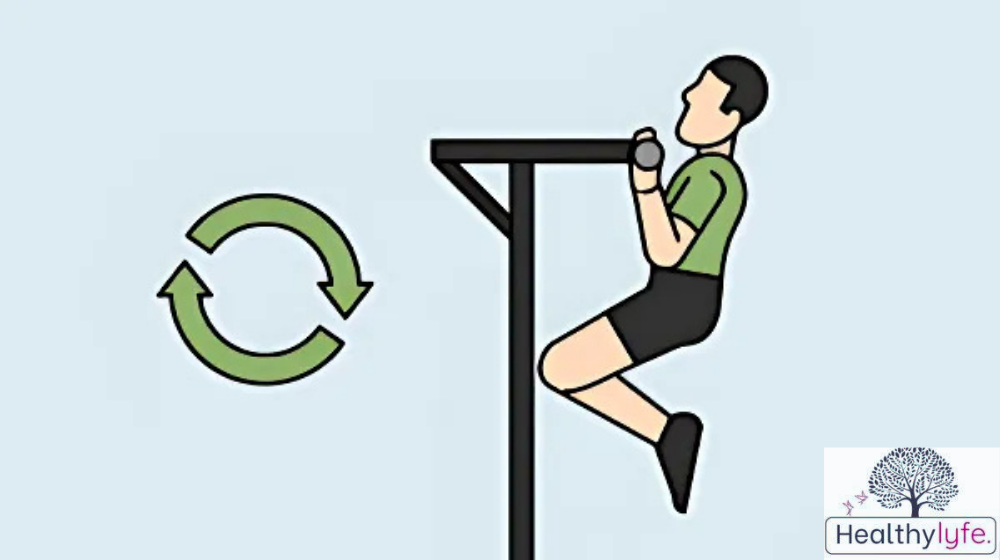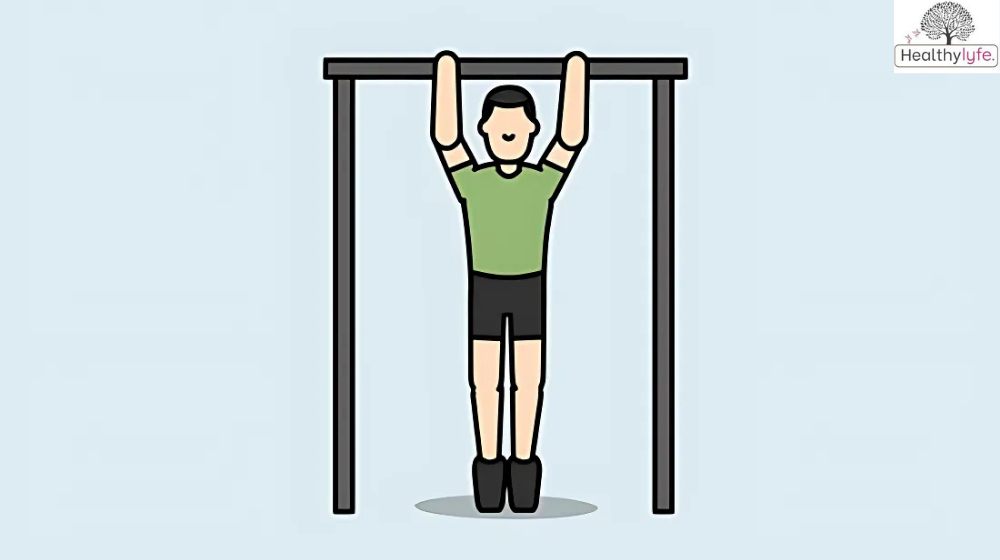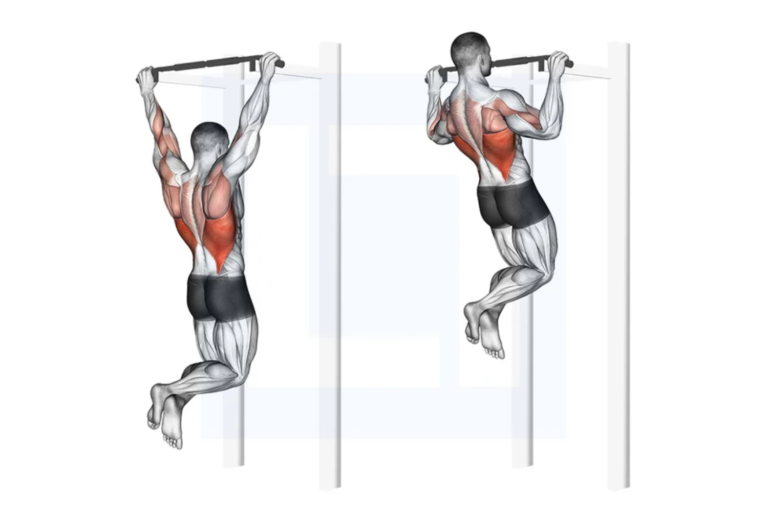Learn everything about pull-ups exercises—benefits, proper form, diet, calories burned, and tips for beginners to advanced athletes.
Introduction
Pull-ups—a simple yet challenging exercise. Whether you’re just starting out or you’re a seasoned gym-goer, pull-ups offer incredible benefits that extend beyond just building back muscles. This full-body exercise is one of the most effective ways to boost your strength, improve posture, and burn fat. In this article, we’ll cover everything you need to know about pull-ups: what they are, the benefits, how they fit into your diet, the calories burned or gained, and much more. By the end, you’ll be ready to incorporate pull-ups into your fitness routine and maximize your results.
What Are Pull-Ups?
Pull-ups are a bodyweight exercise that primarily works your upper body. They involve hanging from a horizontal bar and pulling your body upwards until your chin is above the bar. But while this movement might seem simple, the muscles involved and the benefits you can get from regular practice are anything but basic.
Definition of Pull-Ups
At its core, a pull-up is an upper-body strength exercise that requires you to lift your own body weight. You grip a horizontal bar with both hands, and using the muscles in your back, arms, and shoulders, you pull your body upward until your chin passes the bar. This simple yet intense movement works several muscles simultaneously.
Types of Pull-Ups
There are many variations of pull-ups to target different muscle groups and increase workout intensity. These include:
- Standard Pull-Ups: Palms facing away from you, hands shoulder-width apart.
- Chin-Ups: Palms facing towards you (underhand grip), which engage the biceps more.
- Wide-Grip Pull-Ups: Hands placed wider than shoulder-width to target the lats more effectively.
- Neutral Grip Pull-Ups: Palms facing each other, often easier on the shoulders.
- Kipping Pull-Ups: A dynamic, swinging movement used in CrossFit to get your chin above the bar with momentum.
Proper Form for Pull-Ups [1]

To get the most out of pull-ups and avoid injuries, it’s essential to perform them with proper form:
- Grip: Ensure your hands are firmly gripping the bar with palms facing away (for pull-ups) or toward you (for chin-ups).
- Engage the Shoulders: Before you pull up, engage your shoulder blades by pulling them down and back.
- Core Engagement: Keep your core tight throughout the movement to prevent swinging.
- Movement: Pull your chest toward the bar with control and avoid jerking your body.
- Legs: Keep your legs either straight or slightly bent at the knees to maintain proper form.
Benefits of Pull-Ups
Pull-ups are a compound movement, which means they work multiple muscle groups at once. Here’s how incorporating them into your workout routine can improve both your physical and mental health.
Physical Benefits
Pull-ups are one of the best exercises for building upper-body strength. The primary muscles targeted include:
- Latissimus Dorsi (Lats): These are the large muscles on your back that give you the classic “V-shape.”
- Biceps: Your arm muscles, especially the biceps, are heavily involved as you pull yourself up.
- Trapezius and Rhomboids: These upper back muscles help pull your shoulders back and stabilize your scapula.
- Forearms and Grip Strength: The act of holding onto the bar also improves forearm and grip strength.
- Core: Your abs and obliques play a key role in stabilizing your body as you perform the movement.
Mental and Emotional Benefits
Pull-ups aren’t just physically challenging—they also have mental benefits. Successfully completing a set of pull-ups can boost your self-confidence and sense of accomplishment. Each rep is a mini victory, especially when you’re pushing your limits.
Long-Term Health Benefits
Over time, pull-ups help improve your posture, as they strengthen the muscles in your back and shoulders. This can help prevent slouching and back pain. Regular practice also reduces the risk of shoulder injuries and improves overall muscle endurance and mobility.
Advantages of Pull-Ups
There are several reasons why pull-ups should be a staple in your fitness routine. Here are some of the key advantages of incorporating pull-ups into your workouts.
Accessibility
Pull-ups are one of the most accessible exercises you can do. All you need is a pull-up bar, which can easily be installed at home or found in most gyms. Unlike machines or other equipment-based exercises, pull-ups don’t require any extra tools or memberships—just your body weight.
Full-Body Workout
While pull-ups primarily target your back, shoulders, and arms, they also engage your core, glutes, and even your legs to some extent. As a result, pull-ups are considered a full-body workout, helping to improve overall muscle balance and functional strength.
Enhances Grip Strength
Pull-ups require a firm grip on the bar, which in turn improves your grip strength. A stronger grip can translate to better performance in other exercises like deadlifts, kettlebell swings, and even daily activities like carrying groceries or lifting heavy objects.
Pull-Ups and Diet Plan
What you eat plays a crucial role in supporting muscle growth and overall fitness progress, especially when it comes to an intense exercise like pull-ups.
Nutrition for Muscle Growth
To see significant results from your pull-up training, your diet needs to be aligned with your fitness goals. If muscle growth is the aim, make sure you’re eating enough protein to repair and build muscle tissue. Foods like chicken, fish, eggs, tofu, and legumes are all excellent sources of protein.
In addition to protein, you need healthy fats (avocado, olive oil, nuts) and complex carbohydrates (brown rice, sweet potatoes, oats) to provide your body with the energy it needs for a tough workout and recovery.
Pre-Workout and Post-Workout Nutrition
- Pre-Workout: Eat a light meal 30-60 minutes before your workout, focusing on a combination of protein and carbs. A protein shake with a banana, or a piece of toast with peanut butter, works great.
- Post-Workout: After your pull-up session, aim to consume a meal rich in protein and carbohydrates. A protein smoothie with fruits or grilled chicken with quinoa is a great option to promote muscle recovery and replenish glycogen stores.
Pull-Ups and Calories
One of the most common questions about pull-ups is how many calories they actually burn. Pull-ups, being a bodyweight exercise, are great for burning calories and building muscle at the same time.
How Many Calories Does Pull-Ups Burn?
On average, doing a set of 10 pull-ups burns about 10-15 calories, depending on your body weight, intensity, and form. If you weigh around 150 pounds and perform vigorous pull-ups, you can expect to burn about 7 calories per minute.
Do Pull-Ups Help in Gaining Calories?
While pull-ups themselves don’t directly “gain” you calories, they do help you build muscle. The more muscle mass you have, the higher your resting metabolic rate (RMR) becomes. This means you’ll burn more calories even when you’re not exercising, contributing to a more efficient metabolism.
Calories Burned Based on Intensity
The number of calories burned during pull-ups also depends on how intensely you perform them. Doing explosive pull-ups with a fast tempo burns more calories than slow and controlled reps. You can also increase the intensity by adding weights to your pull-ups, which further boosts calorie burn.
How to Incorporate Pull-Ups in Your Routine

Pull-ups can be incorporated into your workout routine whether you’re a beginner or an advanced lifter. Here’s how you can make pull-ups work for you.
Beginner to Advanced Progression
If you’re new to pull-ups, start with assisted variations. You can use a resistance band or an assisted pull-up machine to help you perform the movement. As you build strength, gradually reduce the assistance until you can do unassisted pull-ups.
For those who are already proficient in pull-ups, you can progress by adding weight (using a weighted vest or belt) or increasing the number of sets and reps.
Frequency and Rest
Pull-ups are an intense exercise that taxes the upper body muscles. Therefore, it’s important to rest between pull-up sessions. Aim for 2-3 pull-up sessions per week, allowing your muscles adequate recovery time.
Common Mistakes to Avoid in Pull-Ups
Pull-ups are deceptively challenging, and many people make mistakes that can affect their form and performance. Here are a few common mistakes to watch out for:
Incorrect Grip
Gripping the bar incorrectly can affect your performance and increase the risk of injury. Make sure your hands are firmly gripping the bar, with your palms facing away from you (for pull-ups) or towards you (for chin-ups).
Lack of Core Engagement
Many people forget to engage their core when doing pull-ups, leading to swinging and reduced effectiveness. Make sure to keep your core tight and avoid any unnecessary movement.
Overtraining
Pull-ups are tough on the upper body muscles, so avoid doing them every day. Overtraining can lead to injury and burnout. Stick to 2-3 sessions per week for optimal results.
Conclusion
Pull-ups are a powerhouse exercise that can help you build muscle, improve strength, and boost your overall fitness. Whether you’re trying to get stronger, build a defined back, or burn calories, pull-ups are a valuable addition to any workout routine. Remember, consistency is key, so keep challenging yourself to improve, and don’t forget to pair your workouts with a well-balanced diet for maximum results. Now get ready to add pull-ups to your fitness journey!
FAQs About Pull-ups
How many pull-ups should I be able to do?
There’s no standard number, as it depends on your fitness level. Beginners may start with 1-3, while intermediate and advanced athletes can aim for 10+ pull-ups in a set.
Are pull-ups good for beginners?
Yes, pull-ups can be done by beginners using assisted variations, like resistance bands or the assisted pull-up machine.
How often should I do pull-ups?
For most people, 2-3 times a week is ideal to avoid overtraining and to allow muscles time to recover.
Do pull-ups help with weight loss?
Yes! While pull-ups themselves aren’t a huge calorie burner, they build muscle, and more muscle means a higher metabolism, which helps with weight loss.
Can women do pull-ups?
Absolutely! Women can perform pull-ups just like men. It may take time and practice to build strength, but it’s completely achievable.
What muscles do pull-ups work?
Pull-ups primarily work your back (lats), shoulders (deltoids), arms (biceps, triceps, and forearms), and core muscles (abs and obliques).
How long does it take to do a full pull-up?
It varies by individual, but most people can perform their first unassisted pull-up within 3 to 6 months with consistent practice and training.
Can I increase my pull-up numbers?
Yes, you can improve your pull-up performance over time by consistently practicing and progressively increasing the intensity (adding weight or reps).
Can I increase my pull-up numbers?
Yes, you can improve your pull-up performance over time by consistently practicing and progressively increasing the intensity (adding weight or reps).
Is it okay to use a band for assistance?
Yes, using resistance bands is a great way for beginners to assist their pull-up form and gradually build strength until they can do an unassisted pull-up.
Do pull-ups improve posture?
Yes! Pull-ups strengthen the muscles in your back, shoulders, and core, which can significantly improve your posture over time.
How do I progress from assisted pull-ups to unassisted?
To progress, gradually reduce the assistance provided by the resistance band or machine. As you build strength, you’ll need less help, eventually leading to unassisted pull-ups.
Should I add weight to my pull-ups?
Once you can perform 10-12 unassisted pull-ups with good form, adding weight (via a weighted vest or belt) is a great way to increase intensity and continue building strength.
What if I can’t do a single pull-up?
Start with assisted pull-ups or negative pull-ups (lowering yourself slowly). Building grip and back strength progressively will help you eventually do a full pull-up.
What’s the best grip for pull-ups?
The most common grip for pull-ups is the overhand grip (palms facing away), but you can also try underhand (chin-ups) or neutral (palms facing each other) grips for variety and targeting different muscles.
Can pull-ups help with back fat?
Yes! Pull-ups target the upper back and help build muscle, which can help reduce back fat when combined with a proper diet and cardio routine.
Can I build muscle with pull-ups alone?
While pull-ups are great for building muscle in the upper body, incorporating a variety of exercises (such as push-ups, squats, and deadlifts) into your routine will ensure balanced muscle development.
How do I improve my pull-up performance?
Progressive overload (adding weight or reps), consistent practice, improving core strength, and using different pull-up variations will help improve your performance.
How many sets and reps should I do?
For beginners, 3 sets of 3-5 reps is a good starting point. As you improve, you can increase the number of sets and reps, aiming for 4-5 sets of 8-12 reps for maximum strength and endurance.
What’s the difference between pull-ups and chin-ups?
Pull-ups have an overhand grip (palms facing away from you) and primarily target the back, while chin-ups use an underhand grip (palms facing toward you) and engage the biceps more.
Can pull-ups help me get rid of love handles?
Pull-ups engage your core and back muscles, helping to tone the torso. However, losing love handles requires a combination of regular exercise, proper nutrition, and overall fat loss through cardio and strength training.
By healthylyfe


